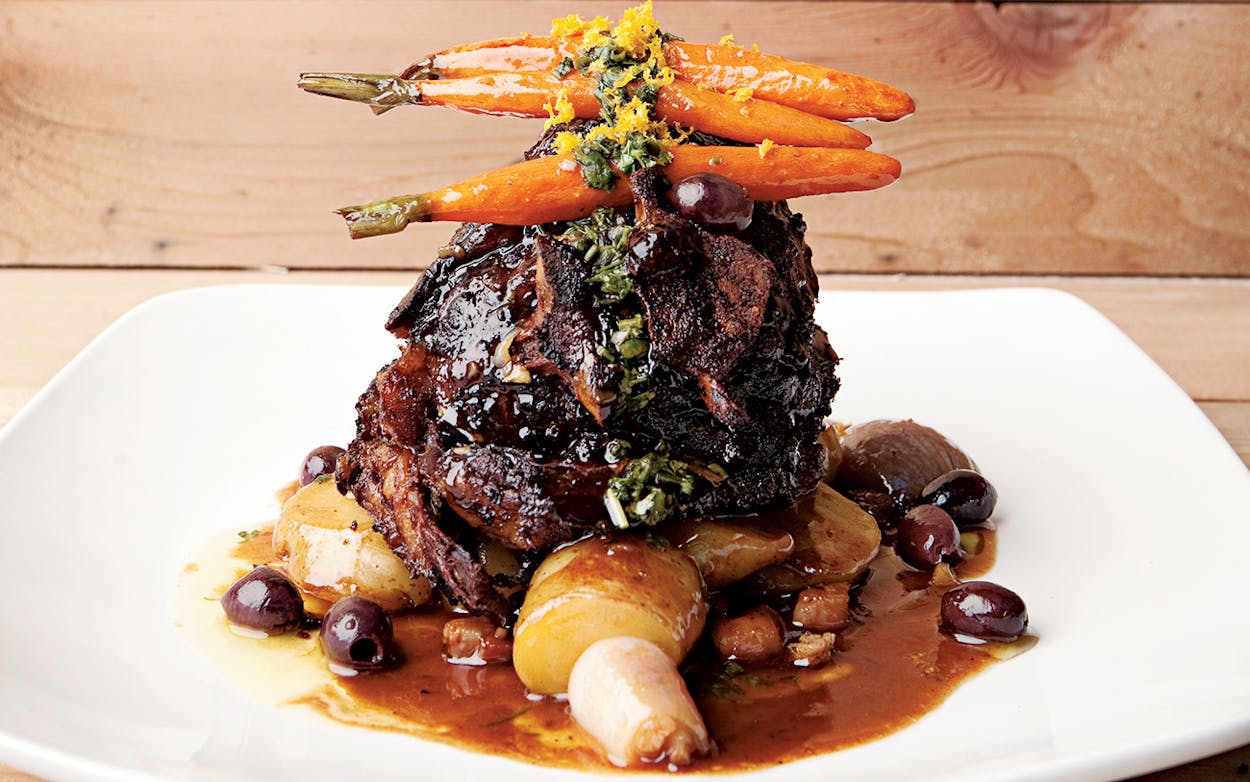“Uh-oh,” said my friend the good doctor, slamming on the brakes a quarter block from Boulevardier. “This doesn’t look promising.” No, it did not. What were we thinking, trying to get into the hottest new restaurant in Oak Cliff on a Friday night? Cars were four deep waiting to be parked, and customers were swarming around the restaurant’s door like sharks. Luckily our friends had arrived earlier and already gotten a table; otherwise we would have been cooling our heels along with the other dillydalliers.
We found our party at a banquette near the front, where I swear I could pick up on telepathic messages from people waiting for a table: “You are getting very, very full . . . You want to leave . . . You will ask for the check.” Usually a box office hit like this is a sign of a glamorous scene, a star chef, and/or cutting-edge food. But Boulevardier was ostensibly a French bistro, replete with antiquated—excuse me, timeless—staples like cassoulet and steak frites. The setting was a rehabbed old mercantile building. The young chef was quite highly regarded but hardly the king of the Twitterverse. What was the deal?
I opened a menu. With its three-column layout and boxes listing specials, it certainly looked French. But here and there were also surprising ingredients, like a root beer braise on the Berkshire pork cheek, not to mention pickled watermelon with the grilled Lockhart quail and field pea succotash. Looking around, I noticed the dining room lacked most of the clichés that signal “French bistro ahead,” like lace curtains; the servers were even wearing plaid shirts. On the other hand, there were mirrors on the wall—très français, those. The place was sending mixed messages. I liked that.
Soon dishes starting arriving from the kitchen at a good clip. The first was the Big Board, a charcuterie sampler arrayed with a beautifully varied selection of house-made meaty spreads ranging from creamy pork rillettes to pistachio-studded country pork pâté. A flurry of forks ensued. In a short while, our efficient waiter was back with another cutting board, this one piled with earthy, brontosaurus-size roasted beef marrowbones, sided by pickled shallots and sweet-onion marmalade. On my personal index, the FLF (food lust factor), these bones ranked near the top. The same was true of the lamb neck daube, a bony but brilliant stew.
After a pause to catch our breath, we decided on three other classics. And that is when things really started to get interesting. Even though the description of the snails didn’t say “à la bourguignonne,” most Americans would expect to see the usual garlic-butter-drenched sextet. Well, not here. This heap of shells-off mollusks shared space with trumpet mushrooms in a demi-glace-like sauce that was as dark as sin and heady with brandy. The slice of bread that made this a tartine was mainly for mopping-up operations. Next was a plate of smoky, lightly grilled oysters in their shells, slicked with casino butter redolent of shallots and Worcestershire. They were also just a bit spicy—alors! And then there was the Bouillabaisse Boulevardier. If there is one thing that defines bouillabaisse, it’s the Mediterranean fish that go into the renowned stew of Marseille. At Boulevardier, the first thought that pops into your head is “Wow—is there some lobster bisque in there?” No, it wasn’t creamy, but the distinctive, almost-burnt taste of roasted lobster shell was unmistakable. The mixed message coming through loud and clear was “French bistro with a Dallas accent.”
Boulevardier’s principals had their work cut out for them when they dreamed up the concept. Co-owner Brooks Anderson says, “We thought there was a niche for chef-driven French bistro fare that wasn’t fussy or formal.” (He co-owns Boulevardier and Veritas with his brother Bradley.) “But,” he adds, “we didn’t want to overdesign it. We wanted it simple and comforting and rustic, in both food and decor.” Executive chef Nathan Tate felt the same. The 31-year-old says, “My culinary training—I went to El Centro College, here in Dallas—is French, and I worked with Dean Fearing at Fearing’s, which has a strong French base. But sometimes I think French dishes can be a little bland and one-note.” Anderson sums it up best: “We wanted it French but not too French.”
So with interior design by Kelly Mitchell, of Mitchell Garman Architects, they put their “French but not too French” plan in motion. Workers stripped the floors of the ninety-year-old building down to the concrete and exposed its warm pink brick walls. “We wanted people to see the nuts and bolts of the structure,” says Anderson. As the final “not too” touch, they put up simple cotton cafe curtains, not lace ones. But since the concept was, after all, Gallic, as a finishing flourish they hung gold mirrors that had belonged to their grand-mère, who was, as it happens, French.
At the same time, Tate was making similar decisions in the kitchen, like nixing bouillabaisse’s traditional fish stock. He admits with a grin, “I thought that in Dallas we would sell a lot of bouillabaisse if we used a lobster stock.” To keep things local, he sought out area producers. The Tate Farms Burger, for instance, comes from grass-fed steers raised on his family’s ranch, near Rockwall. “It doesn’t get more farm-to-table than that,” he says. Southern grits are on the menu; so are Louisiana-influenced crawfish-stuffed beignets.
But no matter how much you try to cover your bases, you never know until you open if all your plans are going to jell. Happily, worries about Dallas’s reaction evaporated immediately. Says Anderson, “We had no break-in period. We did ninety-three covers the first night, a Monday.” The following Friday they had 216 customers. Looking toward the future, Anderson says, “Around the edges there will always be Cajun and Southern, and I think there might be some North African influences coming. But the core menu will always be French bistro.”
Just not, you know, too French.









